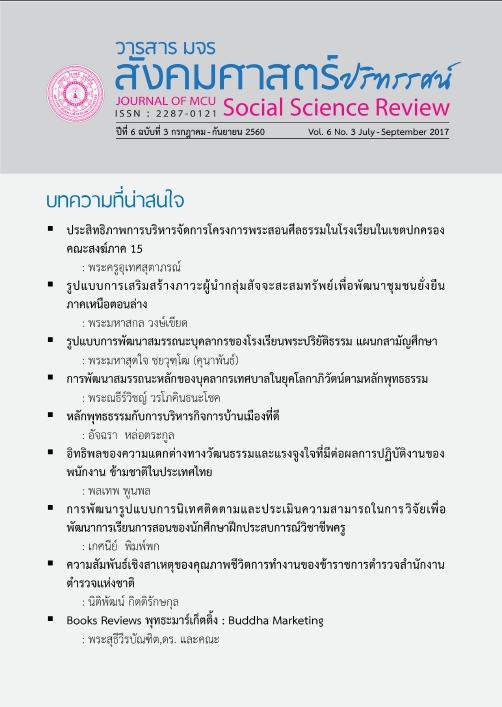การพัฒนารูปแบบการจัดการเรียนรู้ในศตวรรษที่ 21 เพื่อส่งเสริมความคิดสร้างสรรค์ของนักเรียนชั้นประถมศึกษา
คำสำคัญ:
การพัฒนา รูปแบบการจัดการเรียนรู้ในศตวรรษที่ 21 ความคิดสร้างสรรค์บทคัดย่อ
บทความวิจัยนี้มีวัตถุประสงค์ 1. เพื่อศึกษาและพัฒนารูปแบบการจัดการเรียนรู้ในศตวรรษที่ 21 เพื่อส่งเสริมความคิดสร้างสรรค์ 2.เพื่อศึกษาความคิดเห็นของครูผู้สอน ที่มีต่อรูปแบบการจัดการเรียนรู้ในศตวรรษที่ 21 เพื่อส่งเสริมความคิดสร้างสรรค์ 3. เพื่อศึกษาผลของการใช้รูปแบบการจัดการเรียนรู้ในศตวรรษที่ 21 เพื่อส่งเสริมความคิดสร้างสรรค์หลังจากการจัดการเรียนรู้ของนักเรียนชั้นประถมศึกษา และ 4. เพื่อศึกษาความพึงพอใจของนักเรียน ที่มีต่อการนำรูปแบบการจัดการเรียนรู้ในศตวรรษที่ 21 เพื่อส่งเสริมความคิดสร้างสรรค์หลังจากการจัดการเรียนรู้มาใช้จัดการเรียนรู้ กลุ่มตัวอย่างที่ใช้ มี จำนวน 455 คน ประกอบด้วย ครูผู้สอน และผู้เรียน
การดำเนินการวิจัยในครั้งนี้เป็นการวิจัยและพัฒนา มีขั้นตอน ดังนี้
ตอนที่ 1 ศึกษาวิเคราะห์ข้อมูลข้อมูลพื้นฐาน ได้แก่ทฤษฎีการเรียนรู้ส่งเสริมความคิดสร้างสรรค์ การจัดการเรียนรู้ในศตวรรษที่ 21 การบูรณาการ การเรียนรู้สะเต็มศึกษา
การสังเคราะห์งานวิจัย แบบสอบถามความคิดเห็นของครูผู้สอนในระดับประถมศึกษาข้อมูลด้านนักเรียน ซึ่งผลจากการศึกษาพบว่า รูปแบบการจัดการเรียนรู้ในศตวรรษที่ 21 เพื่อส่งเสริมความคิดสร้างสรรค์ ของนักเรียนชั้นประถมศึกษา จะช่วยพัฒนาความคิดสร้างสรรค์ของนักเรียนได้
ตอนที่ 2 การสอบถามความคิดเห็นของครูผู้สอน ที่มีต่อรูปแบบการจัดการเรียนรู้ในศตวรรษที่ 21 เพื่อส่งเสริมความคิดสร้างสรรค์หลังจากการจัดการเรียนรู้ ซึ่งพบว่าครูผู้สอนส่วนมากแสดงความคิดเห็นว่ารูปแบบการจัดการเรียนรู้ในศตวรรษที่ 21 เพื่อส่งเสริมความคิดสร้างสรรค์
ของนักเรียนชั้นประถมศึกษามีความพึงพอใจอยู่ในระดับมาก
ตอนที่ 3 การใช้รูปแบบการจัดการเรียนรู้ในศตวรรษที่ 21 เพื่อส่งเสริมความคิดสร้างสรรค์หลังจากการจัดการเรียนรู้ของนักเรียนชั้นประถมศึกษา ซึ่งกลุ่มตัวอย่างที่ใช้ในการทดลองเป็นนักเรียนระดับชั้นประถมศึกษาปีที่ 3 ภาคเรียนที่ 2 ปีการศึกษา 2558 โดยเปรียบเทียบผลการทดสอบแบบก่อนเรียนและ
หลังเรียน จากการวิจัยพบว่า รูปแบบการจัดการเรียนรู้ใน สตวรรษที่ 21 ส่งเสริมความคิดสร้างสรรค์ ของนักเรียนชั้นประถมศึกษา เป็นรูปแบบการเรียนรู้ที่มี 4 ขั้นตอน คือ ขั้นที่ 1
ขั้นความรู้ การตรวจสอบ สร้างความเข้าใจ ขั้นที่ 2 ขั้นประยุกต์ใช้ ฝึกวิธีการโดยอิสระ ขั้นที่ 3 ขั้นวิเคราะห์ เปรียบเทียบประเมินค่า ขั้นที่ 4 ขั้นคิดสร้างสรรค์ความสามารถในการออกแบบ วางแผน ผลจากการนำรูปแบบการจัดการเรียนรู้ในศตวรรษที่ 21 เพื่อส่งเสริมความคิดสร้างสรรค์หลังจากการจัดการเรียนรู้ของนักเรียนชั้นประถมศึกษา ไปใช้พบว่า รูปแบบการสอนมีประสิทธิภาพตามเกณฑ์ที่กำหนด ดังนี้ คะแนนแบบทดสอบวัดความคิดสร้างสรรค์ของนักเรียนชั้นประถมศึกษาปีที่ 3 ที่มีคะแนนโดยภาพรวม หลังการเรียนรู้ด้วยรูปแบบการจัดการเรียนรู้ในศตวรรษที่ 21 สูงกว่าก่อนเรียน โดยก่อนเรียนมีคะแนนเฉลี่ยเท่ากับ 25.13 คิดเป็นร้อยละ 62.82 และ ค่าเฉลี่ยของคะแนนหลังเรียนจากการเรียนรู้ด้วยรูปแบบการจัดการเรียนรู้ในศตวรรษที่ 21 ของนักเรียนชั้นประถมศึกษา ค่าเฉลี่ยเท่ากับ 34.13 คิดเป็นร้อยละ 85.32
ตอนที่ 4 การศึกษาความพึงพอใจของนักเรียน ที่มีต่อการนำรูปแบบการจัดการเรียนรู้ในศตวรรษที่ 21 เพื่อส่งเสริมความคิดสร้างสรรค์หลังจากการจัดการเรียนรู้ของนักเรียนชั้นประถมศึกษา มาใช้จัดการเรียนรู้ พบว่าความพึงพอใจของนักเรียน ที่มีต่อการนำรูปแบบการจัดการเรียนรู้ส่งเสริมความคิดสร้างสรรค์ โดยรวม อยู่ในระดับพึงพอใจมาก ซึ่งได้ คะแนนเฉลี่ยโดยรวม เท่ากับ 4.16
ผลการวิจัยและพัฒนารูปแบบการจัดการเรียนรู้ในศตวรรษที่ 21 เพื่อส่งเสริมความคิดสร้างสรรค์หลังจากการจัดการเรียนรู้ของนักเรียนชั้นประถมศึกษา ในครั้งนี้อาจกล่าวได้ว่ารูปแบบการจัดการเรียนรู้ในศตวรรษที่ 21 ส่งเสริมความคิดสร้างสรรค์ ดังกล่าว มีประสิทธิภาพ จึงเป็นรูปแบบการจัดการเรียนรู้อีกรูปแบบหนึ่งที่ควรนำไปประยุกต์ใช้ในการจัดการเรียนรู้
เอกสารอ้างอิง
Jaruwan Youngkam.(2509). The results of this study are as follows: With individual And teaching by teacher's manual (Master's thesis). secondary school College Srinakharinwirot University.
Lop Laopaiboon. (1994). Science Teaching Technique. Bangkok: Thailand Wattana Panich.
Ministry of Education. (2008). Basic education. Bangkok: Printing house Products and supplies.
Nopphanesh Thammabuworn. (2006). Early Childhood Development Curriculum Experience for Preschool Children Unit 3. Nonthaburi: Sukhothai Thammathirat University.
Office of Standards and Quality Assessment (2007). External Quality Assessment Report for Secondary Education Level 2 (2004-2010). Bangkok: The Office of Quality Standards and Quality Assessment.
Somporn Lamcharoen. (2009). Developing Curriculum to Enhance Creativity For Grade 2 students. Graduate School Degree in postdoctoral education Srinagarindra University.
Sopol Meencharoen. (2005). Development of Learning Styles Using Multimedia Computer to Develop creative thinking Ed.D (Educational Technology). Bangkok: Graduate School Srinakharinwirot University.
Organizations of Thailand Office of the Higher Education Commission Ministry of Education.
Thanayut Chantarachet (2006). A series of ecological learning activities with natural learning resources. Discovery learning For Prathomsuksa 4 in Chonburi Province. Curriculum and Instruction College Mahasarakrm university.
Wantipa Radrangka (2001). Teaching science with emphasis on process skills. 2nd edition. Bangkok: Thailand Wattana Panich.
Wirun Tangcharoen (2001). Research report. Educational Management Model For the visual arts. Bangkok: National Education Commission
ดาวน์โหลด
เผยแพร่แล้ว
รูปแบบการอ้างอิง
ฉบับ
ประเภทบทความ
สัญญาอนุญาต
ลิขสิทธิ์ (c) 2018 วารสาร มจร สังคมศาสตร์ปริทรรศน์

อนุญาตภายใต้เงื่อนไข Creative Commons Attribution-NonCommercial-NoDerivatives 4.0 International License.
เพื่อให้เป็นไปตามกฎหมายลิขสิทธิ์ ผู้นิพนธ์ทุกท่านต้องลงลายมือชื่อในแบบฟอร์มใบมอบลิขสิทธิ์บทความให้แก่วารสารฯ พร้อมกับบทความต้นฉบับที่ได้แก้ไขครั้งสุดท้าย นอกจากนี้ ผู้นิพนธ์ทุกท่านต้องยืนยันว่าบทความต้นฉบับที่ส่งมาตีพิมพ์นั้น ได้ส่งมาตีพิมพ์เฉพาะในวารสาร มจร สังคมศาสตร์ปริทรรศน์ เพียงแห่งเดียวเท่านั้น หากมีการใช้ภาพหรือตารางหรือเนื้อหาอื่นๆ ของผู้นิพนธ์อื่นที่ปรากฏในสิ่งตีพิมพ์อื่นมาแล้ว ผู้นิพนธ์ต้องขออนุญาตเจ้าของลิขสิทธิ์ก่อน พร้อมทั้งแสดงหนังสือที่ได้รับการยินยอมต่อบรรณาธิการ ก่อนที่บทความจะได้รับการตีพิมพ์ หากไม่เป็นไปตามข้อกำหนดเบื้องต้น ทางวารสารจะถอดบทความของท่านออกโดยไม่มีข้อยกเว้นใดๆ ทั้งสิ้น





